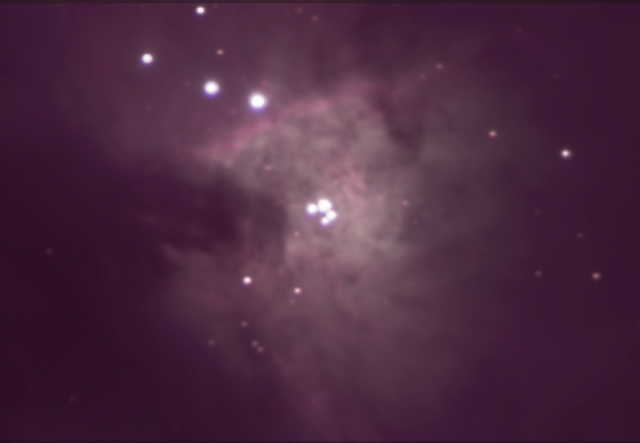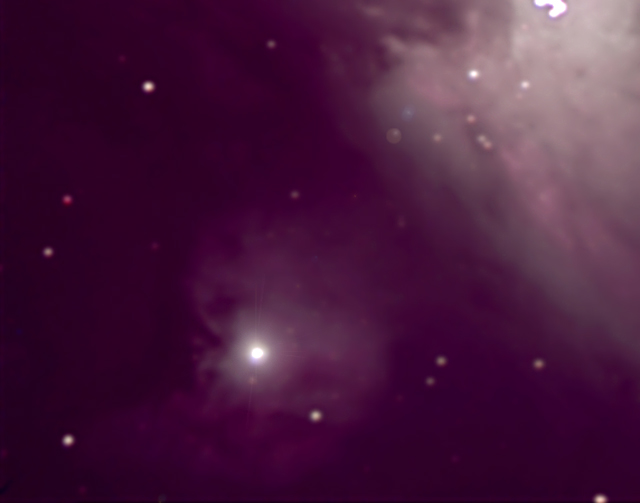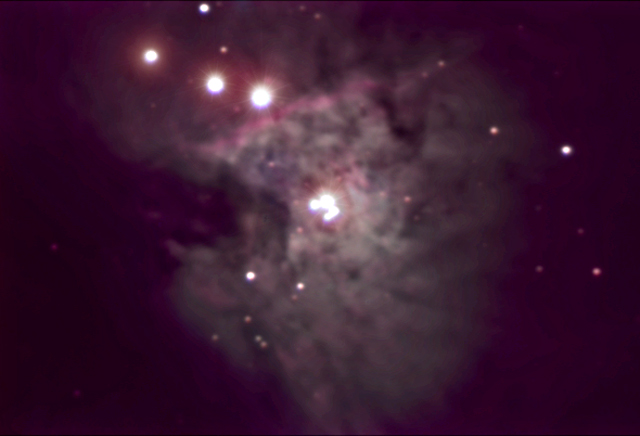
M42 & M43: Great Orion Nebula

RA: 5h 35.4min 24sec Dec: 5º 27' 00" Mag: 4.0 Distance: 1600 light years Constellation: Orion

RA: 5h 35.6min 24sec Dec: 5º 16' 00" Mag: 5.0 Distance: 1600 light years Constellation: Orion
At f6.3, the field of view is still not big enough to encompass in one frame with the DSI, this most spectacular of all deep sky objects. This is the first deep sky object I ever saw with my LX90 one January night and it was one of those moments of one's life which you carry with you to your grave. At the eyepiece of the telescope, the nebulosity glows a mysterious silvery grey-blue, principally because the human retina is insensitive to colour at low light levels, but the DSI can pick up enough energy from the glow to demonstrate its constituent frequencies - shades of red and pink and even blue-green. The top picture shows only the trapezium centre of M42 - the so called, 'fish mouth'. The nebula extends above and below the trapezium for at least one whole field of vision on either side. The lower picture shows M43, lying in front of and below the 'fish's mouth'
These pictures consist of a total of 50 minutes exposure made up as follows, 23x21secs, 21x21, 69x5.7, 17x15, 20x15 and 78x15. They were taken on the night of the 27th of November 2005 with a mild northerly wind and temperatures just above freezing. I processed both the pictures of M42 and M43 in a slightly different way from that of all the other pictures in this website. M42 is notoriously difficult to capture because of the extremely wide range of light intensity from the trapezium to the nebulosity surrounding the stars. Any attempts to adjust contrast and brightness to demonstrate the nebulosity often results in overexposure of the trapezium and turning it into an intense patch of white light. In order to preserve resolution of the centre of M42, I created a layer mask consisting of an opaque negative of the exposure to shield the brightest parts before increasing the brightness of the nebulosity using the levels command in Photoshop. I have carried out no selective modification of the colour and adjusted levels only in RGB (luminosity) so all the colour you see in these pictures were native to the raw image after stacking. Prior to saving as a JPG, I cropped the image to remove the black edges of the stacking process and re-sampled the image with bicubic extrapolation to make the width 640 pixels. The lens flare around the centre of M43 which you see in the picture is rendered - I couldn't resist it!
As a challenge to observe the fine detail (as much as can be captured with the limitations of my system) ni the very centre of M42, I experimented with digital unsharp masking in Photoshop, using a technique described by Jerry Lodriguss in his excellent e-manual on astrophotography processing. A duplicate of the image above was made and large amounts of Gaussian blur were applied until stars were no longer resolved and there was just a smear of the nebulosity visible. Using the Brightness/Contrast command, both of these parameters are reduced drastically until the smear can barely be seen. This is then subtracted from the original using the 'Apply Image' command to remove the obscuration of the background from the image. The result is shown below: observe the fine detail of blue green nebulosity around the trapezium! Hardly as visible in the original. Once again, the lens flares are rendered!

HOME PICTURES: Deep Sky PICTURES: Solar system PICTURES: Wide field